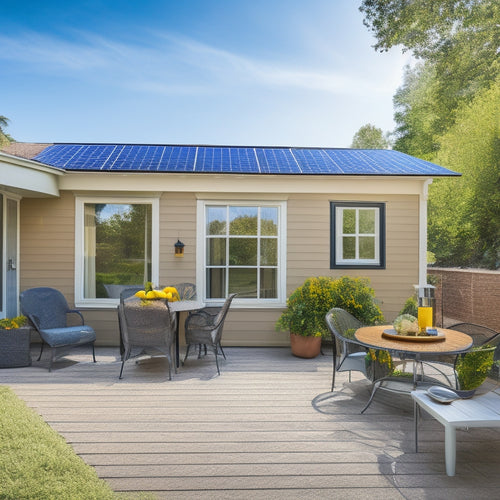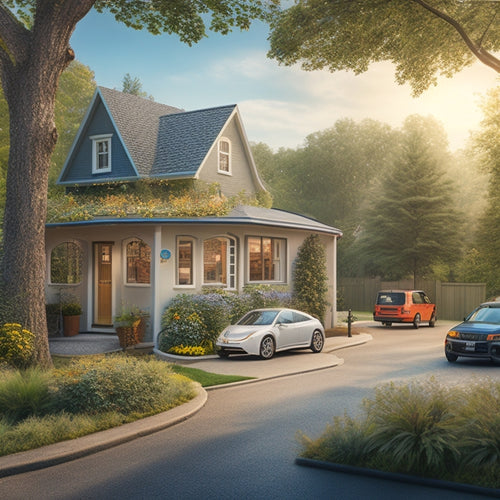
Buying a Solar Power System: Key Considerations
Share
When buying a solar power system, you'll need to assess your energy needs by calculating your daily energy consumption and identifying peak usage periods. You'll also want to understand the different types of solar panels, such as monocrystalline and polycrystalline, and consider factors like system size, configuration, and quality. Additionally, you'll need to think about inverters, energy storage, and installation and maintenance costs. Moreover, you should examine available incentives, such as federal tax credits and financing options, to find the best fit for your budget. As you weigh these key considerations, you'll be well on your way to designing an efficient and cost-effective solar power system that meets your specific energy needs, and understanding the complexities of each factor will be essential in maximizing your investment.
Key Takeaways
- Assess your energy needs by calculating total electricity usage and analyzing usage patterns for appliances like air conditioning and heating.
- Choose the right solar panel type based on efficiency, aesthetics, and cost, considering options like monocrystalline, polycrystalline, thin-film, bifacial, and PERC panels.
- Ensure the system size and configuration meet your energy demands, and consider factors like roof orientation, shading, and grid compatibility.
- Prioritize quality and durability by selecting modules meeting IEC standards, evaluating panel material quality, and considering warranty terms and environmental impact.
- Evaluate financing options, including federal tax credits, state incentives, and financing plans like leasing, power purchase agreements, and loans, to find the best fit for your budget.
Assessing Your Energy Needs
You're looking to invest in a solar power system, and the first step is to determine your energy needs. To do this, you need to calculate your energy consumption, which is the total amount of electricity your home or business uses over a given period. This will help you determine the size of the solar power system you need to meet your energy demands.
Start by reviewing your past electricity bills to identify your peak usage periods. Are you a heavy user of air conditioning in the summer or electric heating in the winter? Do you have a large family or a home office that consumes a lot of power? Understanding your energy usage patterns will help you determine the maximum amount of power you need to generate.
Next, you'll need to calculate your daily energy consumption in kilowatt-hours (kWh). This will give you a clear illustration of your energy needs and help you choose a solar power system that can meet those needs.
Understanding Solar Panel Types
Understanding Solar Panel Types
When choosing a solar power system, you'll encounter various solar panel types. Each type has its strengths and weaknesses, which affect your system's overall performance and appearance. You'll want to take into account factors like solar efficiency ratings and panel aesthetics to make an informed decision.
Here's a breakdown of popular solar panel types:
| Panel Type | Efficiency Rating | Aesthetics |
|---|---|---|
| Monocrystalline | 15-20% | Sleek, uniform appearance |
| Polycrystalline | 12-15% | Less uniform, but still attractive |
| Thin-Film | 7-14% | Less efficient, but flexible and affordable |
| Bifacial | 15-20% | High-efficiency, dual-sided panels |
| PERC | 18-22% | High-efficiency, with added reflective layer |
While higher efficiency ratings often come with a higher price tag, they can provide more power per hour of sunlight. On the other hand, you may prioritize panel aesthetics to guarantee a visually appealing installation. Weigh your options carefully to find the best balance for your solar power system.
System Size and Configuration
Now that you've selected your ideal solar panel type, it's time to determine the best system size and configuration for your specific energy needs. This involves calculating the total power output required to meet your energy demands.
Consider your current energy consumption, taking into consideration factors like appliance efficiency and usage patterns.
You'll also need to assess your roof's solar potential, considering variables like orientation, shading, and available space. A larger system may be necessary if your roof receives partial shading or has limited space.
Make certain your system is grid-compatible, allowing you to feed excess energy back into the grid and offset your consumption during periods of low sunlight.
When configuring your system, consider system aesthetics, balancing visual appeal with functional requirements. A well-designed system should be both efficient and visually pleasing.
Consider the layout, module arrangement, and racking system to create a harmonious look that complements your property. By carefully selecting the right system size and configuration, you'll maximize your energy harvest while maintaining a sleek, modern appearance.
Quality and Durability Matters
When you're investing in a solar power system, you expect it to last for decades.
That's why you need to look for modules that meet rigorous durability standards, such as those set by the International Electrotechnical Commission (IEC).
The quality of the panel material and the warranty and guarantee offered by the manufacturer are also critical factors to evaluate.
Module Durability Standards
The International Electrotechnical Commission (IEC) sets stringent module durability standards for solar panels, guaranteeing they withstand various environmental stresses and last for decades. When buying a solar power system, you want to confirm the modules can withstand harsh weather conditions, including extreme temperatures, humidity, and UV exposure.
| Test Category | Description |
|---|---|
| Thermal Cycling | Evaluates module performance under repeated temperature fluctuations |
| Humidity Freeze | Assesses module durability in high humidity and freezing conditions |
| UV Exposure | Measures module resistance to UV radiation |
These tests are essential in evaluating module durability and efficiency. Look for modules with high efficiency ratings, as they'll provide more power per hour of sunlight. Additionally, consider the environmental impact of the modules. Durable modules reduce electronic waste and minimize the carbon footprint of your solar power system. By choosing modules that meet IEC standards, you'll enjoy a reliable and efficient solar power system that lasts for years to come.
Panel Material Quality
Most solar panels are constructed with one of two primary materials: polycrystalline silicon and monocrystalline silicon. You'll want to understand the differences between these materials to make an informed decision.
Polycrystalline silicon panels are less expensive, but their panel efficiency is lower due to the presence of impurities in the silicon crystal structure. This results in a slightly lower energy output per hour of sunlight.
Monocrystalline silicon panels, on the other hand, have a higher panel efficiency, but they're more expensive. They're also more environmentally friendly since they're made from higher-purity silicon, reducing the environmental impact of production.
When evaluating panel material quality, consider the trade-offs between cost and efficiency. If you prioritize maximum energy output, monocrystalline silicon might be the better choice. However, if budget is a concern, polycrystalline silicon panels can still provide reliable performance.
Ultimately, your decision should be based on your specific energy needs and budget constraints.
Warranty and Guarantee
Frequently, solar panel manufacturers offer warranties and guarantees that serve as a demonstration to the quality and durability of their products. When buying a solar power system, you should carefully review the warranty terms to make certain they align with your expectations.
A thorough warranty typically covers defects in materials and workmanship, as well as performance guarantees. Look for warranties that guarantee a certain level of energy production over a specified period, usually 25 years or more.
You should also consider the length of the warranty, with longer warranties typically indicating higher-quality products. Additionally, check if the warranty is transferable in case you decide to sell your property.
A solid warranty and guarantee can provide peace of mind, as they protect your investment and guarantee you receive the energy output you need. Be wary of manufacturers with vague or unclear warranty terms, as this could indicate a lack of confidence in their products.
Inverters and Energy Storage
Energy freedom relies on inverters and energy storage, the backbone of a solar power system.
You'll need to take into account these critical components to guarantee a reliable and efficient energy supply.
When selecting an inverter, look for high inverter efficiency to maximize your energy output.
You'll also need to choose the right inverter type, such as a string inverter, microinverter, or power optimizer, depending on your system's configuration and needs.
For energy storage, take into account the following key factors:
- Storage capacity: determine how much energy you need to store to meet your power requirements
- Grid integration: confirm your system can seamlessly integrate with the grid when needed
- Battery lifespan: choose batteries with a long lifespan to minimize replacement costs
- Energy management: select a system that can effectively manage energy distribution and consumption
- Inverter compatibility: verify your inverter and energy storage system are compatible to guarantee peak performance
Installation and Maintenance Costs
When planning your solar power system, consider that installation and maintenance costs can greatly impact your overall investment. These costs can add up quickly, especially if you don't carefully plan your system's design and installation.
You'll want to make certain that your solar panel placement is ideal for energy production. A well-designed system will consider factors like roof slope, shading, and wiring distance to maximize energy output. This attention to detail can reduce installation costs and increase your system's overall efficiency.
Regular maintenance is also essential to guarantee your system operates at peak performance. Maintenance frequency will depend on factors like panel type, environmental conditions, and system size.
You'll need to budget for regular cleaning, inspection, and potential repairs to keep your system running smoothly. Be sure to factor these costs into your overall budget to avoid surprise expenses down the line.
Carefully considering installation and maintenance costs upfront will help you get the most out of your solar power system investment.
Incentives and Financing Options
When you're buying a solar power system, you'll want to take advantage of the incentives and financing options available to you.
You can claim federal tax credits, which can greatly reduce the upfront cost of your system, and many states offer additional incentives, such as rebates or tax credits.
Additionally, financing plans are offered by some manufacturers and installers, allowing you to spread the cost over several years.
Federal Tax Credits
As you investigate your solar power system options, you'll likely want to take advantage of the federal tax credits available to homeowners and businesses.
These credits can greatly reduce the upfront costs of installing a solar power system, making it more affordable and increasing your return on investment.
To qualify for federal tax credits, you'll need to meet certain federal guidelines. Here are some key points to keep in mind:
- The Solar Investment Tax Credit (ITC) allows you to claim a credit of 26% of the total cost of your solar power system.
- You must have tax liability to claim the credit, and it can be carried over for up to five years.
- The credit applies to the total cost of the system, including installation, equipment, and permitting fees.
- The system must be placed in service during the tax year, and you must own the system (leasing doesn't qualify).
- You'll need to file IRS Form 5695 with your tax return to claim the credit.
State Incentives Available
Your solar power system investment can also benefit from state incentives, which vary by location but often provide additional financial benefits. These incentives can greatly reduce the upfront cost of your system and increase your return on investment.
| State Incentive Type | Description | Benefit |
|---|---|---|
| State Tax Credits | Dollar-for-dollar reduction in state taxes owed | 10%-20% of system cost |
| Local Rebates | Cash rebates from local governments or utilities | $0.10-$0.50 per watt |
| Renewable Energy Certificates (RECs) | Tradable certificates representing 1 MWh of renewable energy | $10-$50 per REC |
| Utility Incentives | Special rates or discounts from utilities for solar customers | 5%-10% reduction in electricity rates |
| Solar Access Laws | Protections for solar customers from restrictions or fees | Guarantees unhindered access to solar power |
Some states also offer community solar programs, which allow multiple individuals or organizations to share the benefits of a single solar array. Additionally, solar access laws guarantee that you're protected from any restrictions or fees that might limit your ability to generate solar power. Be sure to research the specific incentives available in your state to maximize your solar power system's financial benefits.
Financing Plans Offered
A solar power system's sticker price can be intimidating, but fortunately, various financing plans are available to help make the investment more accessible. You have several options to evaluate, each with its pros and cons.
-
Leasing options: Pay a monthly fee to use the solar power system, with the installer retaining ownership.
-
Power purchase agreements: Pay for the electricity generated, often at a lower rate than traditional utilities.
-
Flexible financing: Loans or financing plans with varying interest rates and repayment terms.
-
Credit score impact: Know that financing plans may require a good credit score, affecting the interest rates and lender requirements.
-
Upfront costs vs long term savings: Weigh the initial investment against the long-term savings on energy bills.
When exploring these options, evaluate the interest rates, lender requirements, and upfront costs.
It's crucial to find a financing plan that aligns with your financial situation and goals. By doing so, you'll be able to utilize the power of solar energy while minimizing the financial burden.
Frequently Asked Questions
Can I Install a Solar Power System Myself to Save Money?
You can attempt a DIY installation to save money, but it's essential to weigh the cost savings against potential risks, such as safety hazards, incorrect installation, and voiding the warranty, which may end up costing you more in the long run.
How Long Does It Take to Install a Solar Power System?
You'll be thrilled to know that the installation timeline is only a few days, but don't expect to binge-watch Netflix while the pros work their magic; the installation process involves careful planning, precise panel placement, and rigorous testing - it's not a DIY YouTube tutorial.
Will Solar Panels Affect My Roof's Warranty or Integrity?
You'll want to guarantee your solar panels won't void your roof's warranty or compromise its integrity; check roof material compatibility and warranty implications beforehand, as some systems may require additional support or modifications to guarantee a secure, watertight installation.
Can I Expand My Solar Power System in the Future if Needed?
Embracing the freedom to adapt, you'll be thrilled to know that you can seamlessly upgrade your solar power system in the future, thanks to system compatibility designed for effortless future upgrades, granting you the power to evolve with your energy needs.
Will Solar Panels Still Generate Power During a Blackout?
You'll be glad to know that your solar panels won't generate power during a blackout, as a safety feature, but you can prepare for blackout preparedness by installing a battery backup system to guarantee continuous power supply, maintaining solar panel functionality.
Related Posts
-

10 Tips to Buy Affordable Solar Panels Online
When purchasing affordable solar panels online, you'll want to research reputable retailers, compare prices, and chec...
-

Why Nearby EV Conversion Shops Matter to You
Having a nearby EV conversion shop means you'll experience the benefits of a more personalized, convenient, and susta...
-

What Role Do Unicycles Play in Urban Transport?
As you navigate through congested city streets, unicycles emerge as a viable solution, slashing carbon emissions by u...


